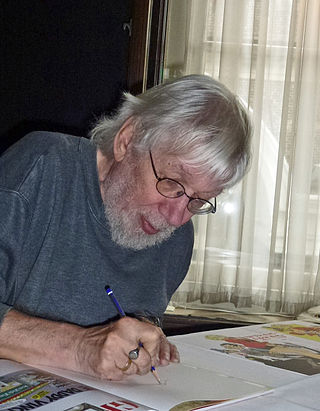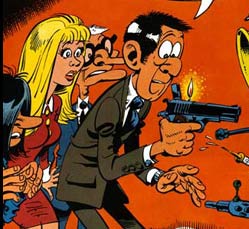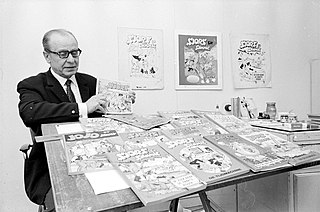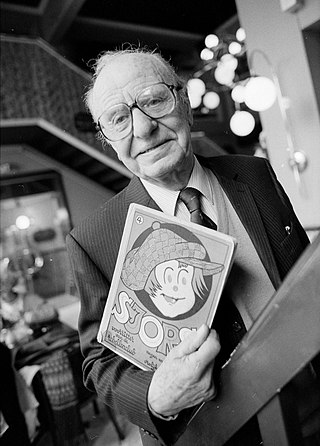Publication history
Franka originally appeared in the weekly comic magazine Pep which, in 1975, merged with Sjors into Eppo . Franka became one of the magazine's fixtures for the next eleven years (1984 being her one sabbatical-year). In 1988 Eppo became Sjors & Sjimmie but it took another year before Franka made her comeback. In 1992 she returned to annual appearances starting at the beginning of the year. After Sjors & Sjimmie (or Sjosji as it was known since 1994) ceased publication in 1999 Franka went on to become the subject of her own online magazine. In February 2009 Eppo was revived as a forthnightly magazine appealing to original readers as well as their offspring; Franka is one of several household names to be included. In January 2010, she was voted Dutch comic strip heroine of all time.
From the 1990s onwards, Franka was also serialised in Veronica Magazine , the magazine of Veronica TV, which with weekly sales of over 1,000,000 was among the most widely circulated Dutch periodicals.
Franka has also been published in German, Spanish, Catalan, Galician, Scandinavian languages, as well as in French ( Spirou).
Incidents from previous volumes are often referred to in the subsequent ones, although they can be read independently.
[2] [3]
Albums in the official series
The following are the Dutch language editions. From volume 1 to volume 8 the publisher was Oberon, from volume 9 to 15, Big Balloon, and from volume 16 Franka BV.
1. Het Misdaadmuseum (Criminology Museum) (1978)
2. Het Meesterwerk (The Masterpiece) (1978)
3. De Terugkeer van de Noorderzon (The Return of the Noorderzon) (1978)
4. De Wraak van het Vrachtschip (The Revenge of the Freighter) (1979)
- De Terugkeer van de Noorderzon and De Wraak van het Vrachtschip together form one episode.
5. Circus Santekraam (1981) (includes the episode Animal Day).
6. Het Monster van de Moerplaat (The Swamp Monster) (1982)
- also includes the episodes Pyromaniac and Saboteur.
7. De Tanden van de Draak (The Dragon's Teeth) (1984)
8. De Ondergang van de Donderdraak (The Dragon's Downfall) (1986)
- De Tanden van de Draak and De Ondergang van de Donderdraak together form one episode.
9. Moordende Concurrentie (Murderous Competition) (1990)
10. Gangsterfilm (Gangster Movie) (1992)
11. De Vlucht van de Atlantis (Flight of the Atlantis) (1993)
12. De Blauwe Venus (The Blue Venus) (1994)
13. De Dertiende Letter (The Thirteenth Letter) (1995)
14. Het Portugese Goudschip (The Portuguese Gold Ship) (1996)
15. De Ogen van de Roerganger (The Eyes of the Oarsman) (1997)
- Het Portugese Goudschip and De Ogen van de Roerganger together form one episode.
16. Succes Verzekerd (Success Guaranteed) (1999)
17. Eigen risico (At Your Own Risk) (2001)
- Succes Verzekerd and Eigen Risico together form one episode.
18. Kidnap (2004)
19. Het zwaard van Iskander (The Sword of Iskander) (2006)
20. De Witte Godin (The White Goddess) (2009)
21. Het Zilveren Vuur (The Silver Fire) (2010)
- Het zwaard van Iskander, De Witte Godin and Het Zilveren Vuur together form the trilogy De reis van de Ishtar (The Journey of Ishtar)
22. Onderwereld (Underworld) (2012)
23. Geheim 1948 (Secret 1948) (2016)
24. Operatie Roofmoord (Operation Robbery and Murder) (2019)













